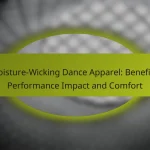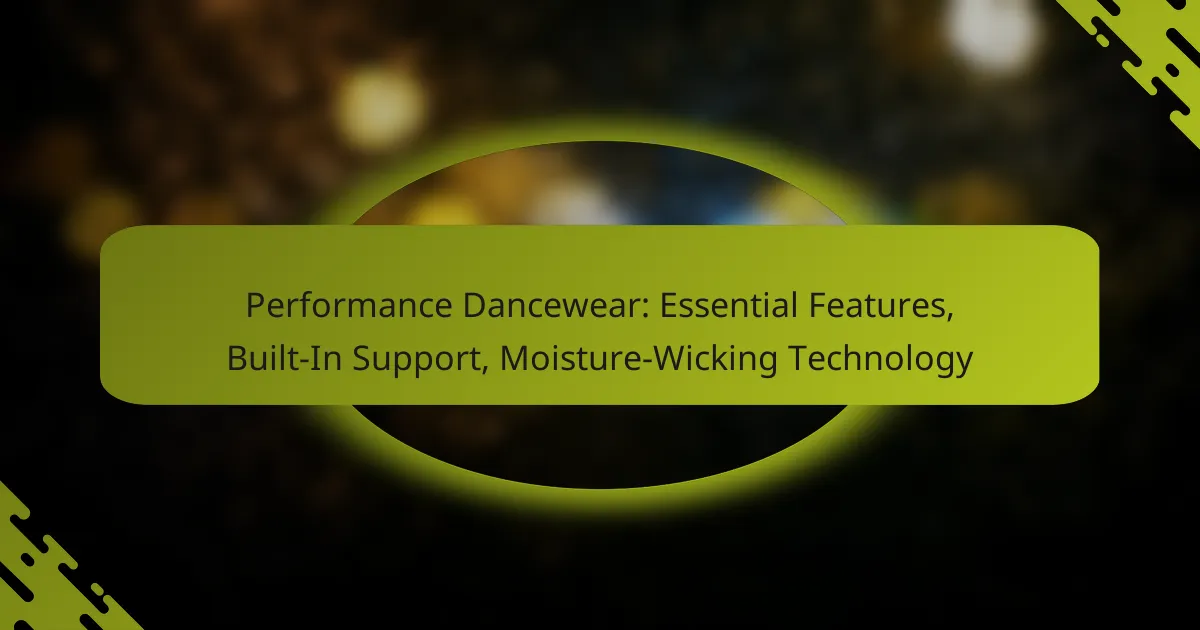When selecting dancewear with built-in support, dancers should consider key factors such as material quality, fit, and the level of support provided. High-quality brands focus on combining comfort and functionality, allowing performers to maintain proper alignment and enhance their technique. By prioritizing these elements, dancers can ensure they feel secure and confident during practice and performances.

What are the best dancewear brands with built-in support?
Several dancewear brands are renowned for their high-quality products that incorporate built-in support for dancers. These brands prioritize comfort, functionality, and style, ensuring that dancers can perform at their best while feeling secure.
Bloch
Bloch is a leading name in dancewear, known for its innovative designs that include built-in support features. Their leotards and tights often come with integrated bras or support panels, providing essential coverage and comfort during performances.
When selecting Bloch products, consider the specific type of dance you practice, as their offerings cater to various styles, from ballet to contemporary. Look for options with adjustable straps for a customizable fit.
Capezio
Capezio has a long-standing reputation in the dance community, offering a wide range of dancewear with built-in support. Their garments often feature supportive linings and bra cups, making them suitable for both training and performances.
It’s advisable to check the sizing charts carefully, as Capezio’s fit can vary by style. Their products are particularly popular among ballet dancers for their elegant designs and reliable support.
Gaynor Minden
Gaynor Minden specializes in high-performance dancewear that combines functionality with style. Their leotards and tights are designed with built-in support systems that enhance comfort and stability, crucial for rigorous dance routines.
Consider their unique materials that offer stretch and durability, which are essential for dancers who require both flexibility and support. Their products are often favored by professional dancers for their quality and design.
Danskin
Danskin is well-known for its versatile dancewear, including options with built-in support. Their leotards often feature soft, stretchy fabrics that provide comfort and support without compromising on style.
When choosing Danskin, look for styles that offer moisture-wicking properties, which can be beneficial during intense rehearsals. Their products are generally affordable, making them accessible for dancers at all levels.
Wear Moi
Wear Moi is a French brand that emphasizes elegance and functionality in its dancewear. Their garments typically include built-in support features, such as integrated bras and supportive seams, catering to dancers who prioritize both aesthetics and performance.
Pay attention to the fabric choices, as Wear Moi often uses high-quality materials that enhance movement while providing necessary support. Their unique designs are particularly appealing for those looking to stand out in class or on stage.

How does built-in support enhance performance for dancers?
Built-in support in dancewear significantly enhances performance by providing essential stability and comfort during movement. This type of support helps dancers maintain proper alignment and reduces distractions, allowing them to focus on their technique and artistry.
Improved comfort
Comfort is crucial for dancers, as it directly affects their ability to perform. Dancewear with built-in support often features soft, breathable fabrics that conform to the body, minimizing chafing and irritation. Look for options with seamless designs or moisture-wicking materials to enhance comfort during long rehearsals or performances.
Additionally, the right level of support can prevent unnecessary pressure points, allowing dancers to move freely without feeling restricted. Choosing dancewear that fits well and provides adequate support can make a significant difference in overall comfort levels.
Enhanced stability
Built-in support provides enhanced stability, which is vital for executing complex movements. This stability helps dancers maintain balance during turns, jumps, and other dynamic actions. Look for garments with features like reinforced bodices or structured cups that offer targeted support where it’s needed most.
When selecting dancewear, consider the type of dance being performed. For instance, ballet dancers may benefit from leotards with more structured support, while contemporary dancers might prefer softer, more flexible options that still provide adequate stability.
Reduced injury risk
Injury prevention is a key concern for dancers, and built-in support can help mitigate risks. Properly designed dancewear can reduce strain on muscles and joints by promoting correct posture and alignment. This is especially important during high-impact movements or extended practice sessions.
Dancers should pay attention to how their dancewear fits and supports their body. Ill-fitting garments can lead to discomfort and increase the likelihood of injuries. Investing in quality dancewear with built-in support is a proactive step towards maintaining long-term health and performance quality.

What features should dancers look for in supportive dancewear?
Dancers should prioritize material quality, fit and sizing, and support level when selecting supportive dancewear. These features ensure comfort, freedom of movement, and adequate support during performances and practice.
Material quality
The material of dancewear significantly affects comfort and performance. Look for fabrics that are breathable, moisture-wicking, and stretchy, such as spandex blends or high-quality cotton. These materials help regulate body temperature and allow for a full range of motion.
Additionally, consider the durability of the fabric. Dancewear should withstand frequent washing and rigorous movement without losing its shape or support. Checking for reinforced seams can also indicate higher quality.
Fit and sizing
A proper fit is crucial for supportive dancewear, as it directly impacts performance and comfort. Ensure that the dancewear is snug but not restrictive, allowing for movement without slipping or bunching. Sizes can vary by brand, so always refer to sizing charts and consider trying items on when possible.
Pay attention to specific areas that require a good fit, such as the waist, bust, and leg openings. Adjustable features like straps or waistbands can enhance fit and provide additional support where needed.
Support level
The level of support in dancewear varies widely, depending on the type of dance and individual needs. For high-impact styles like ballet or jazz, look for garments with built-in bras or compression features that provide adequate bust support. This helps prevent discomfort and injury during intense movements.
For styles requiring more flexibility, such as contemporary dance, consider lighter support options that still offer stability without restricting movement. Always assess your personal comfort and performance needs when evaluating support levels in dancewear.

How does sizing affect the effectiveness of built-in support?
Sizing plays a crucial role in the effectiveness of built-in support in dancewear. Properly fitted garments ensure that the support functions as intended, providing stability and comfort during movement.
Importance of accurate measurements
Accurate measurements are essential for selecting dancewear with built-in support. Dancers should measure their bust, waist, and hips to find the correct size, as even slight discrepancies can lead to inadequate support. Using a flexible measuring tape and following size charts from manufacturers can help achieve the best fit.
It’s advisable to try on different styles and brands, as sizing can vary significantly. Considerations like body shape and personal comfort preferences should also influence the final choice.
Impact on mobility
The right sizing directly impacts a dancer’s mobility. If the dancewear is too tight, it can restrict movement and cause discomfort, while overly loose garments may not provide the necessary support. Finding a balance is key to maintaining freedom of movement while ensuring effective support.
Dancers should look for features like adjustable straps or elastic bands that can accommodate slight size variations without compromising mobility. Testing the garment with various movements, such as stretching or jumping, can help assess its performance in action.

What are the price ranges for dancewear with built-in support?
Dancewear with built-in support typically falls into three main price categories: budget, mid-range, and high-end. Prices can vary significantly based on the brand, materials, and design features, with budget options starting at lower prices and high-end selections reaching premium costs.
Budget options
Budget dancewear with built-in support usually ranges from around $20 to $50. These options often include basic leotards and tights that provide essential support without additional features. While they may lack advanced materials or design, they are suitable for beginner dancers or those on a tight budget.
When choosing budget options, look for items made from durable fabrics that can withstand regular use. Check for customer reviews to ensure they offer adequate support and comfort during practice.
Mid-range selections
Mid-range dancewear typically costs between $50 and $100. This category often features better quality materials, enhanced support, and stylish designs. Brands in this range may offer specialized features such as moisture-wicking fabrics or adjustable support elements.
For mid-range selections, consider the fit and style that best suits your dancing needs. Investing in a few versatile pieces can provide both comfort and durability for regular use.
High-end choices
High-end dancewear with built-in support usually starts at around $100 and can exceed $200. These premium options often include advanced technology, such as compression fabrics and ergonomic designs, tailored for serious dancers. Brands in this category are known for their quality craftsmanship and stylish aesthetics.
When opting for high-end choices, prioritize brands that are well-regarded in the dance community. These pieces can enhance performance and provide long-lasting wear, making them a worthwhile investment for dedicated dancers.

What are the return policies for dancewear purchases?
Return policies for dancewear purchases can vary significantly by retailer. Generally, most stores offer a return window of 30 to 60 days, allowing customers to return items that do not meet their expectations.
Understanding Return Windows
Return windows are the timeframes during which you can return dancewear for a refund or exchange. Many retailers provide a 30-day return policy, while some may extend this to 60 days or more, especially during holiday seasons. Always check the specific policy of the retailer before making a purchase.
Condition of the Items
Most retailers require that dancewear be returned in its original condition, which typically means unworn, unwashed, and with tags still attached. If the item shows signs of wear or has been altered, it may not be eligible for a return. This is particularly important for specialized items like leotards or tights.
Shipping Costs and Refunds
When returning dancewear, consider the shipping costs. Some retailers offer free return shipping, while others may deduct return shipping fees from your refund. It’s essential to read the return policy details to understand how refunds are processed and whether you will be responsible for any shipping costs.










